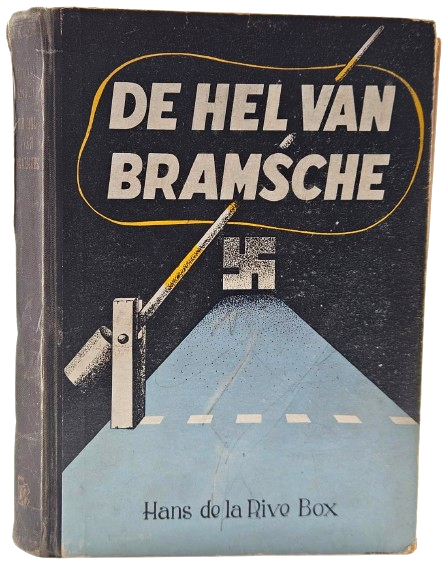The Hell of Bremsha – Testimony of a Dutch Prisoner in the German Camp of Bremsha. Netherlands, 1945 – First Edition – Signed Copy by the Author
DE HEL VAN BRAMSCHE DOOR HANS DE LA RIVE BOX – "The Hell of Bramsche" – A harrowing testimony by Hans de la Rive Box, a Dutch prisoner deported to the camp in 1944. A chilling account of months spent between life and death. Published by F.G. KROONDER, Bussum (Netherlands), 1945 – First edition. Dutch. Signed copy by the author.
The memoirs of prisoner Hans in the Bramsche forced labor camp (Northwest Germany). At the beginning of the book, the author states that his account is based entirely on real events, providing a faithful depiction of the brutal conditions in Germany between 1944-1945, though he refrains from describing the worst atrocities, fearing the book might fall into the hands of young readers. He adds: "By the way, it is impossible to describe the German beasts…" Hans details his arrest at home for hiding a Jewish girl, the tortures he endured in detention, his deportation to Bramsche, how he was transformed overnight from a free man into a battered prisoner, the death of his Jewish friends one by one from dysentery, the daily struggle for survival, the personal torture he endured more than his fellow prisoners at the hands of the barracks commander, who saw him as a "leader" secretly inciting the inmates, until the moment he saw American bombers at the Dutch-German border, realizing liberation was near, and ultimately his rescue. (During his time in Bramsche, Hans became acquainted with the German residents living near the camp, noting that while they hated Hitler and his regime, they still saluted every passing SS convoy out of sheer terror.)
Bramsche was one of the Nazi forced labor and detention camps during World War II, located in the town of Bramsche in northwest Germany, near the city of Osnabrück and the Dutch border. It was part of the Nazi camp system, where prisoners of war—primarily Soviet, Polish, and French soldiers, as well as Jews and others persecuted under the Nazi regime—were held. The camp primarily functioned as a forced labor camp, where prisoners were assigned to work in factories and construction projects, including the military industry. As part of the Nazi regime’s forced labor policies, the camp was designed to extract maximum labor from prisoners under brutal conditions. Detainees were forced to build military infrastructure, manufacture military equipment, and perform other forced labor, often under extreme brutality, malnutrition, lack of medical care, and unhygienic conditions. The Nazis also transferred other "undesirable" populations to the camp, in line with their ideological policies.
Living conditions in the camp were inhumane. Prisoners were forced to work long hours under starvation conditions and subjected to extreme cruelty to deter any thoughts of resistance or escape. Many were executed or murdered arbitrarily, while countless others perished from disease, starvation, and forced labor. In the final stage of World War II in 1945, as the Soviet army neared the German border, Bramsche was liberated by British soldiers on April 3, 1945. According to testimonies, at the time of liberation, the camp held between 4,000 and 5,000 prisoners, many of whom were physically and mentally broken, suffering from severe malnutrition and disease.
247 pages. Good condition. Printed on slightly striped paper typical of the wartime paper shortage. Impressive cover – an illustration of an open barricade leading to a path at the end of which a swastika appears.






